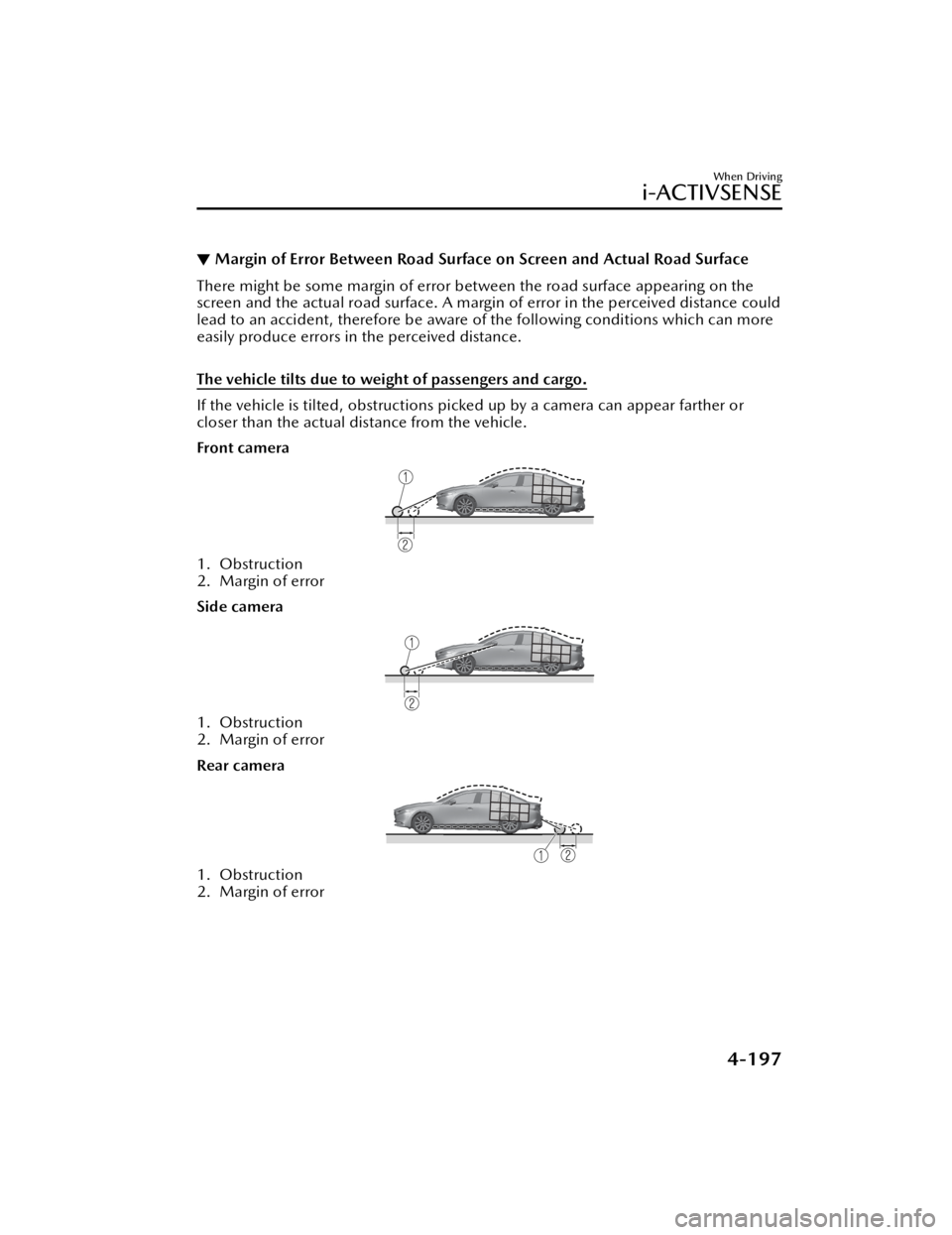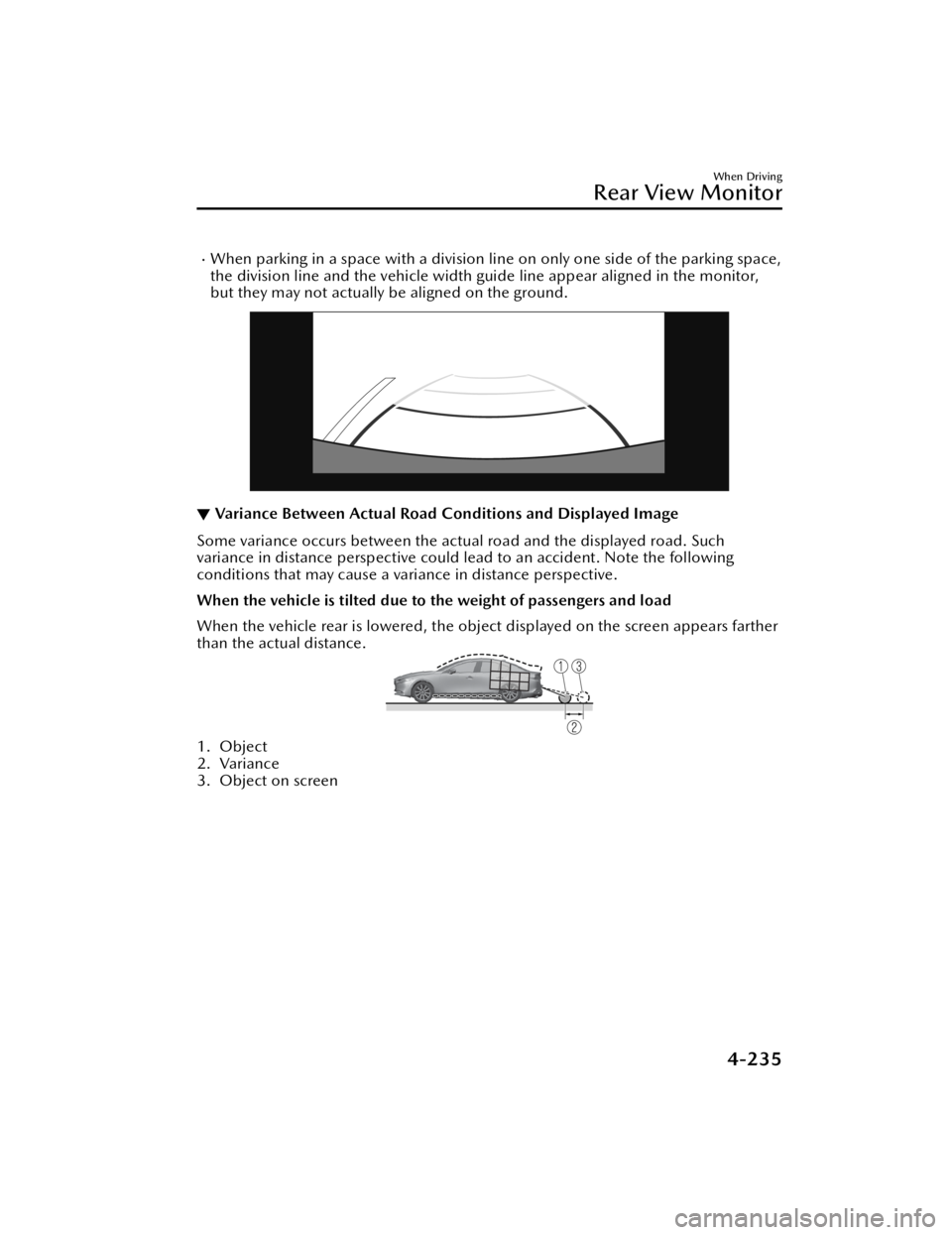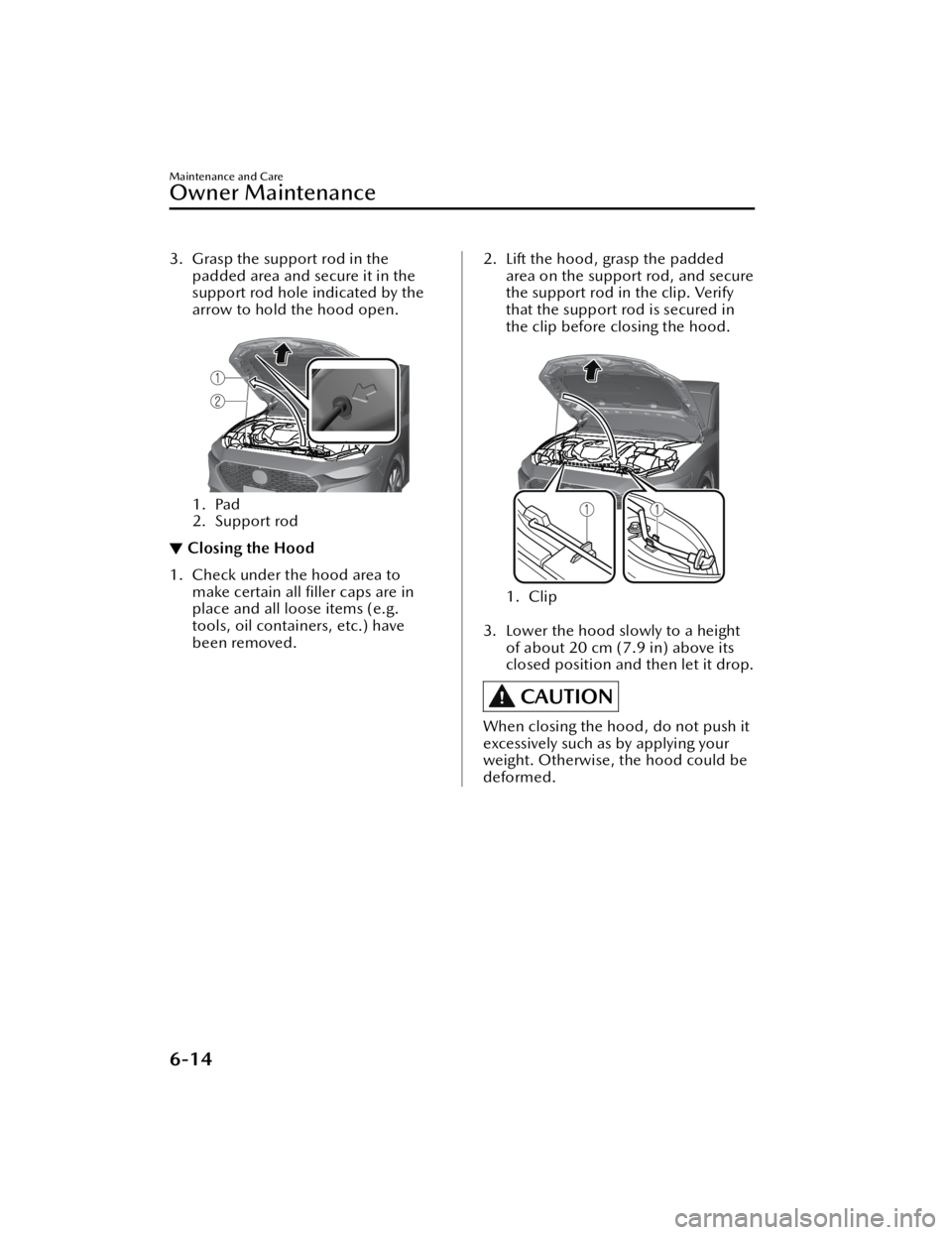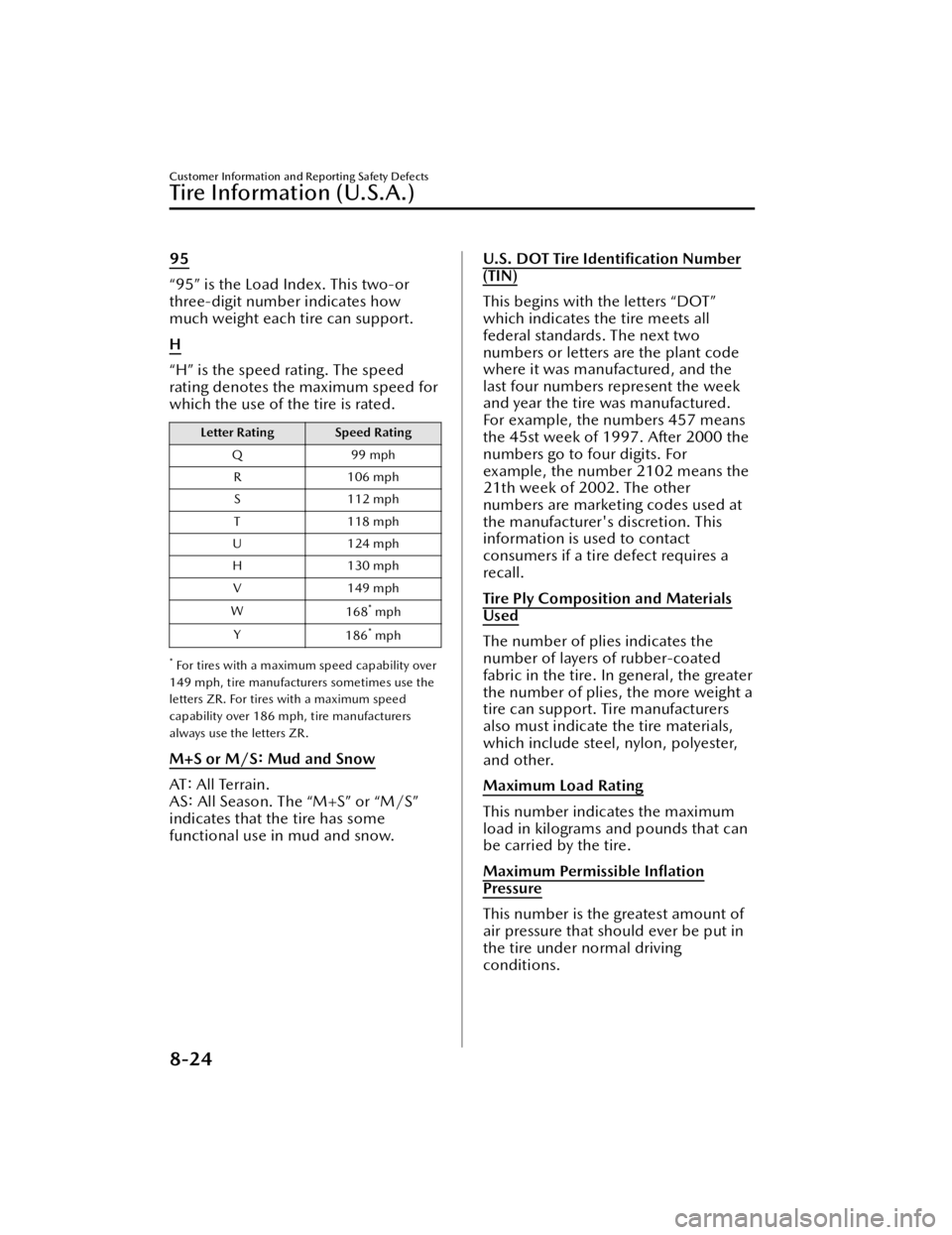weight MAZDA MODEL 3 HATCHBACK 2021 Owner's Manual
[x] Cancel search | Manufacturer: MAZDA, Model Year: 2021, Model line: MODEL 3 HATCHBACK, Model: MAZDA MODEL 3 HATCHBACK 2021Pages: 612, PDF Size: 89.06 MB
Page 339 of 612

▼Margin of Error Between Road Surface
on Screen and Actual Road Surface
There might be some margin of error between the road surface appearing on the
screen and the actual road surface. A margin of error in the perceived distance could
lead to an accident, therefore be aware of the following conditions which can more
easily produce errors in the perceived distance.
The vehicle tilts due to weight of passengers and cargo.
If the vehicle is tilted, obstructions picked up by a camera can appear farther or
closer than the actual distance from the vehicle.
Front camera
1. Obstruction
2. Margin of error
Side camera
1. Obstruction
2. Margin of error
Rear camera
1. Obstruction
2. Margin of error
When Driving
i-ACTIVSENSE
4-197
Mazda3_8JM2-EA -20H_Edition1_new 2020-7-10 17:21:34
Page 377 of 612

When parking in a space with a division line on only one side of the parking space,
the division line and the vehicle width guide line appear aligned in the monitor,
but they may not actually be aligned on the ground.
▼Variance Between Actual Road Conditions and Displayed Image
Some variance occurs between the actual road and the displayed road. Such
variance in distance perspective could lead to an accident. Note the following
conditions that may cause a variance in distance perspective.
When the vehicle is tilted due to the weight of passengers and load
When the vehicle rear is lowered, the object displayed on the screen appears farther
than the actual distance.
1. Object
2. Variance
3. Object on screen
When Driving
Rear View Monitor
4-235
Mazda3_8JM2-EA
-20H_Edition1_new 2020-7-10 17:21:34
Page 452 of 612

3. Grasp the support rod in thepadded area and secure it in the
support rod hole indicated by the
arrow to hold the hood open.
1. Pad
2. Support rod
▼Closing the Hood
1. Check under the hood area to
make certain all filler caps are in
place and all loose items (e.g.
tools, oil containers, etc.) have
been removed.
2. Lift the hood, grasp the padded area on the support rod, and secure
the support rod in the clip. Verify
that the support rod is secured in
the clip before closing the hood.
1. Clip
3. Lower the hood slowly to a height of about 20 cm (7.9 in) above its
closed position and then let it drop.
CAUTION
When closing the hood, do not push it
excessively such as by applying your
weight. Otherwise, the hood could be
deformed.
Maintenance and Care
Owner Maintenance
6-14
Mazda3_8JM2-EA -20H_Edition1_new 2020-7-10 17:21:34
Page 471 of 612

9. Install the upper cover.
10.Insert the tabs of the lower coverinto the slots of the transmitter and
install the lower cover.
Tires
▼Tires
For reasons of proper performance,
safety, and better fuel economy, always
maintain recommended tire
inflation
pressures and stay within the
recommended load limits and weight
distribution.
WARNING
Using Di fferent Tire Types:
Driving your vehicle with di fferent
types of tires is dangerous. It could
cause poor handling and poor braking;
leading to loss of control.
Except for the limited use of the
temporary spare tire, use only the
same type tires (radial, bias-belted,
bias-type) on all four wheels.
Using Wrong-Sized Tires:
Using any other tire size than what is
speci fied for the vehicle (page 9-10)
is dangerous. It could seriously a ffect
ride, handling , ground clearance, tire
clearance, and speedometer
calibration. This could cause you to
have an accident. Use only tires that
are the correct size speci fied for the
vehicle.
Maintenance and Care
Owner Maintenance
6-33
Mazda3_8JM2-EA -20H_Edition1_new 2020-7-10 17:21:34
Page 530 of 612

▼Seat Belt Warning Indication/
Warning Light (Front seat)
The seat belt warning light turns on if
the driver or front passenger's seat is
occupied and the seat belt is not
fastened with the ignition switched
ON.
If the driver or front passenger's seat
belt is unfastened (only when the front
passenger's seat is occupied) and if the
vehicle is driven at about 20 km/h (12
mph) or faster, or about 10 km/h (6
mph) or faster for a continuous 30
seconds, with the seat belt unfastened,
the warning light
flashes for a certain
period. After a short time, the warning
light stops flashing, but remains
illuminated.
NOTE
The warning light flashes for about 6
seconds if the driver or front
passenger's seat is not fastened
when the ignition is switched ON.
(Except Mexico)
Placing heavy items on the front
passenger's seat may cause the front
passenger's seat belt warning
function to operate depending on
the weight of the item.
To allow the front passenger
occupant classi fication sensor to
function properly, do not place and
sit on an additional seat cushion on
the front passenger's seat. The
sensor may not function properly
because the additional seat cushion
could cause sensor interference.
If a small child is seated on the front
passenger's seat, the warning light
may not operate.
Action to be taken
Fasten the seat belts.
▼ Seat Belt Warning Light (Rear seat)
(Red)
If the rear seat belts are not fastened
while the ignition is switched ON , the
driver and the passenger are alerted by
the warning light.
The warning light operates even if there
is no passenger on the rear seat.
NOTE
If a rear seat belt is not fastened by a
certain period of time after the engine
has been started, the warning light
turns off
.
Action to be taken
Fasten the seat belts.
▼ Low Washer Fluid Level Warning
Indication/Warning Light*
This warning light indicates that little
washer
fluid remains.
Action to be taken
Add washer fluid (page 6-22).
If Trouble Arises
Warning/Indicator Lights and Warning Sounds
7-36*Some models.
Mazda3_8JM2-EA -20H_Edition1_new 2020-7-10 17:21:34
Page 537 of 612

Mexico
If the vehicle speed exceeds about 20
km/h (12 mph) with the driver or front
passenger's seat belt unfastened, a
warning beep sounds continuously. If
the seat belt remains unfastened, the
beep sound stops once and then
continues for about 90 seconds. The
beep stops after the driver or front
passenger's seat belt is fastened.
Until a seat belt is fastened or a given
period of time has elapsed, the beep
sound will not stop even if the vehicle
speed falls below 20 km/h (12 mph).
NOTE
Placing heavy items on the front
passenger's seat may cause the front
passenger's seat belt warning
function to operate depending on
the weight of the item.
To allow the front passenger seat
weight sensor to function properly,
do not place and sit on an additional
seat cushion on the front passenger's
seat. The sensor may not function
properly because the additional seat
cushion could cause sensor
interference.
If a small child is seated on the front
passenger's seat, the warning beep
may not operate.
Rear seat
The warning beep only sounds if a seat
belt is unfastened after being fastened.
▼ Ignition Not Switched O
ff (STOP)
Warning Beep
If the driver's door is opened with the
ignition switched to ACC, a beep will
be heard continuously in the cabin to
notify the driver that the ignition has
not been switched OFF (STOP). Under
this condition, the keyless entry system
will not operate, the vehicle cannot be
locked, and the battery voltage will be
depleted.
▼ Key Removed from Vehicle
Warning Beep
Vehicles with advanced keyless
function
If the key is taken out of the vehicle
while the ignition is switched to ACC
or ON, and all the doors are closed, a
sound is activated 6 times outside of
the vehicle and a sound is activated 1
time in the vehicle.
Vehicles without advanced keyless
function
If the key is taken out of the vehicle
while the ignition is switched to ACC
or ON, and all the doors are closed, a
sound is activated 1 time in the
vehicle.
NOTE
Make sure that you leave the vehicle
while carrying the key, or switch the
ignition OFF.
If Trouble Arises
Warning/Indicator Lights and Warning Sounds
7-43
Mazda3_8JM2-EA
-20H_Edition1_new 2020-7-10 17:21:34
Page 570 of 612

95
“95” is the Load Index. This two-or
three-digit number indicates how
much weight each tire can support.
H
“H” is the speed rating. The speed
rating denotes the maximum speed for
which the use of the tire is rated.
Letter Rating Speed RatingQ 99 mphR 106 mph
S 112 mph
T 118 mph
U 124 mph
H 130 mph
V 149 mph
W 168
* mph
Y 186
* mph
* For tires with a maximum speed capability over
149 mph, tire manufacturers sometimes use the
letters ZR. For tires with a maximum speed
capability over 186 mph, tire manufacturers
always use the letters ZR.
M+S or M/S: Mud and Snow
AT
: All Terrain.
AS : All Season. The “M+S” or “M/S”
indicates that the tire has some
functional use in mud and snow.
U.S. DOT Tire Identi fication Number
(TIN)
This begins with the letters “DOT”
which indicates the tire meets all
federal standards. The next two
numbers or letters are the plant code
where it was manufactured, and the
last four numbers represent the week
and year the tire was manufactured.
For example, the numbers 457 means
the 45st week of 1997. After 2000 the
numbers go to four digits. For
example, the number 2102 means the
21th week of 2002. The other
numbers are marketing codes used at
the manufacturer's discretion. This
information is used to contact
consumers if a tire defect requires a
recall.
Tire Ply Composition and Materials
Used
The number of plies indicates the
number of layers of rubber-coated
fabric in the tire. In general, the greater
the number of plies, the more weight a
tire can support. Tire manufacturers
also must indicate the tire materials,
which include steel, nylon, polyester,
and other.
Maximum Load Rating
This number indi cates the maximum
load in kilograms and pounds that can
be carried by the tire.
Maximum Permissible In flation
Pressure
This number is the greatest amount of
air pressure that should ever be put in
the tire under normal driving
conditions.
Customer Information and Reporting Safety Defects
Tire Information (U.S.A.)
8-24
Mazda3_8JM2-EA -20H_Edition1_new 2020-7-10 17:21:34
Page 572 of 612

T115/70D16 90M is an example of a
tire size and load index rating. Here is
an explanation of the various
components of that tire size and load
index rating. Note that the tire size and
load index rating may be different from
the example.
T
Indicates a tire that may be installed on
cars, SUVs, minivans and light trucks as
designated by the Tire and Rim
Association (T&RA).
115
“115” is the nominal width of the tire
in millimeters. This three-digit number
gives the width in millimeters of the
tire from sidewall edge to sidewall
edge. In general, the larger the
number, the wider the tire.
70
“70” is the aspect ratio. This two-digit
number indicates the tire's ratio of
height to width.
D
“D” is the tire cons truction symbol. D
indicates “diagonal ply construction”.
16
“16” is the wheel rim diameter in
inches.
90
“90” is the Load Index. This two-or
three-digit number indicates how
much weight each tire can support.
M
“M” is the speed rating. The speed
rating denotes the maximum speed for
which the use of the tire is rated.
Letter Rating Speed Rating
M 81 mph
Customer Information and Reporting Safety Defects
Tire Information (U.S.A.)
8-26
Mazda3_8JM2-EA-20H_Edition1_new 2020-7-10 17:21:34
Page 574 of 612

7. Repeat with each tire, including thespare.
NOTE
Some spare tires require higher
inflation pressure.
8. Visually inspect the tires to make sure there are no nails or other
objects embedded that could poke
a hole in the tire and cause an air
leak.
9. Check the sidewalls to make sure there are no gouges, cuts, bulges,
cracks or other irregularities.
▼Glossary of Terms
Tire Placard:
A label indicating the OE
tire sizes, recommended inflation
pressure, and the maximum weight the
vehicle can carry.
Tire Identi fication Number (TIN):
A
number on the sidewall of each tire
providing information about the tire
brand and manufacturing plant, tire
size, and date of manufacture.
In flation Pressure:
A measure of the
amount of air in a tire.
kPa: Kilopascal, the metric unit for air
pressure.
psi: Pounds per square inch, the
English unit for air pressure.
B -pillar: The structural member at the
side of the vehicle behind the front
door.
Original Equipment (OE): Describes
components originally equipped on
the vehicle.
Vehicle Load Limit: The maximum
value of the combination weight of
occupants and cargo.
Bead Area of the Tire: Area of the tire
next to the rim.
Sidewall Area of the Tire: Area
between the bead area and the tread.
Tread Area of the Tire: Area on the
perimeter of the tire that contacts the
road when it's mounted on the
vehicle.
Seating capacity means the total
allowable number of vehicle
occupants. Seating capacity is
described on the tire label.
Production options weight is the
combination weight of installed regular
production options weighing over 2.3
kilograms in excess of the standard
items which they replace, and not
previously considered in the curb
weight or accessory weight, including
heavy duty brakes, ride levelers, roof
rack, heavy duty battery, and special
trim.
Rim is the metal support (wheel) for a
tire or a tire and tube assembly upon
which the tire beads are seated.
Customer Information and Reporting Safety Defects
Tire Information (U.S.A.)
8-28
Mazda3_8JM2-EA -20H_Edition1_new 2020-7-10 17:21:34
Page 577 of 612

Ve h i c l e L o a d i n g
▼Ve h i c l e L o a d i n g
WARNING
Do not tow a trailer with this vehicle:
Towing a trailer with this vehicle is
dangerous because it has not been
designed to tow a trailer and doing so
will
aff ect the drive system which could
result in vehicle damage.
This section will guide you in the
proper loading of your vehicle, to keep
your loaded vehicle weight within its
design rating capability. Properly
loading your vehicle will provide
maximum return of vehicle design
performance. Before loading your
vehicle, familiarize yourself with the
following terms for determining your
vehicle's weight ratings, from the
vehicle's Safety Certi fication Label and
Tire and Load Information Label:
WARNING
Overloaded Vehicle:
Overloading a vehicle is dangerous.
The results of overloading can have
serious consequences in terms of
passenger safety. Too much weight on
a vehicle's suspension system can
cause spring or shock absorber failure,
brake failure, handling or steering
problems, irregular tire wear, tire
failure or other damage.
Overloading makes a vehicle harder to
drive and control. It also increases the
distance required for stopping. In cases
of serious overloading, brakes can fail
completely, particularly on steep
grades. The load a tire will carry safely
is a combination of the size of the tire,
its load range, and corresponding
in flation pressure.
Never overload the vehicle and always
observe the vehicle's weight ratings
from the vehicle's Safety Certi fication
and Tire and Load Information labels.
Base Curb Weight is the weight of the
vehicle including a full tank of fuel
and all standard equipment. It does
not include passengers, cargo, or
optional equipment.
Vehicle Curb Weight is the weight of
your new vehicle when you picked it
up from your dealer plus any
aftermarket equipment.
PAY LOA D
Customer Information and Reporting Safety Defects
Tire Information (U.S.A.)
8-31
Mazda3_8JM2-EA -20H_Edition1_new 2020-7-10 17:21:34